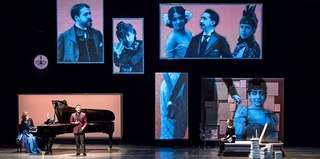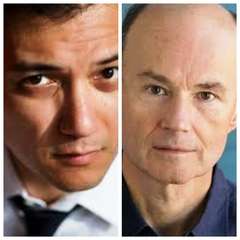|
Back
Images Of the Artist New York
Alliance Française
01/10/2018 - January 11,12,2018
A Proust Sonata: 7 Tableaux en Musique (Conceived and directed by Sarah Rothenberg, based on Marcel Proust’s In Search of Lost Time and the memoirs of Céleste Albaret, Monsieur Proust)
Claude Debussy: Des pas sur la neige
Robert Schumann: Des Abends, Opus 12 No. 1
Gabriel Fauré: Two movements from Sonata No. 1 in A Major, Opus 13 – Ici-bas!, Opus 8 No. 3
Maurice Ravel: Une barque sur l’océan
Frédéric Chopin: Berceuse, Opus 57
Ludwig van Beethoven: Lento assai from String Quartet No. 16 in F Major, Opus 135
Reynaldo Hahn: Rêverie – Mai – Si mes vers avaient des ailes – Antoine Watteau – Fêtes galantes
Léon Delafosse: Mensonges
Henry Stram (Narrator/Marcel), Nicholas Phan (Tenor), Nancy Hume (Céleste)
Boson Mo (Violin), Daedalus String Quartet: Min-Young Kim, Matilda Kaul (violins), Jessica Thompson (viola), Thomas Kraines (cello)
Sarah Rothenberg (Pianist; Scenario and text adaptation), Marina Draghici (Set and Costumes), Hanna Wasileski (Projection), Jennifer Tipton (Lighting), Bart Fasbender (Sound)
Co-presented with Da Camera of Houston Productions; Developed in part at Bard College and 3-Legged Dog Art and Technology Center in New York, Moody Center for the Arts at Rice University

S. Rothenberg/M. Proust (© DaCamera of Houston)
“If not for the invention of language, the formation of words, the analysis of ideas, music might be the means of communication between souls.”
Marcel Proust, The Captive and the Fugitive
Mann, Rolland, Joyce and Proust were perhaps the only major 20th Century writers for whom music was more than note. Music was symbol, memory, structure, metaphor, and frequently a replacement for vocal articulation. Each novelist’s choices were essentially constrained by their countries, but for the German, Irishman and Frenchmen, music was as much a language as their native tongues.
Now Sarah Rothenberg, who had previously created stage works for Pierrot Lunaire ans Messiaen’s Quartet for the End of Time, and made some splendid recordings of rare piano works, has conceived the impossible: a musical treatment of Marcel Proust.
Proust Sonata makes not the slightest attempt at replicating Remembrance of Things Past, which was obviously impossible. The French film made of a Proust novel was beautifully “coiffed”, but basically it was (in Eliot’s words) “a room where people come and go”). It was not Proust.
Ms. Rothenberg offers here a sensuous, sometimes ravishing conception of acting, music, immaculate videos and a corporeal picture of the artist in multiple guises.
First, with his own writings, second, the music which moved him most (including the fictional “Vinteuil Sonata”), Proust’s visits to the seaside, to various salons, to his bedside where he composed his novels.
Second, Proust as seen by his helper, by the musicians who loved him, and, thanks to this truly beautiful setting, a New York audience which (mea culpa) like this writer, may never have gotten past Swann’s pastry icon. Proust had treated the delicate madeleine and tea like New Yorkers treat doughnuts and coffee, delicately dunking it into the brew. And the rest is literary history. (Ms. Rothenberg left the scene to the very end, so audiences could say, “Oh, yes, I remember that part.”)

Proust Sonata set (© Da Camera of Houston and Alliance Française
How did Ms. Rothenberg manage this Herculean task? The stage, designed by Marina Draghici, was made for the task. To the left was the piano, with enough room for “Proust” to sit, and for a singer to stand and sing Proust’s favorites. To the right was the seat and the piles of books, and a bed for the author. In the center were screens of various shapes, upon which stunning projections were made.
We had (as the picture above shows), characters out of the Proust cosmology. We had that iconic painting by Jan Vermeer, a series of images described with finite detail by Proust.
Most stunning of all, in his visit to the seaside, only a dark image standing in the sea, the waves initially murmurs, the light changing, the sea throwing up its froth resembling Monet or Renoir or a Japanese ink block.).
The music for that seascape–for Ms. Rothenberg’s choice of music was impeccable–was her own recital of Ravel’s Une barque sur l’océan. She is a splendid pianist, and her essays throughout the whole work were as expressive as the lighting, the projections, the staging.
For each of the seven parts of this uninterrupted conception, few of which shared the original Proust title, Sarah Rothenberg provided music which either literally or metaphorically (as in the Ravel) was performed by some sterling performers.
The rich, almost-baritone tenor voice of Nicholas Phan, as performed music which would have taken place at a salon. First, the Venezuelan lover of Proust, Reynaldo Hahn, a then song by Fauré, a song written by Proust himself. At another point, Proust uses a new-fangled telephone-thing to hear music from the Paris Opera (also sung by Phan), and at his bedside, his imagination summon up the movement of a late Beethoven string quartet.
One of the most moving tiny signs here ushered in this work. The Daedalus Quartet moves into Proust’s dark bedroom, and in his imagination, cellist Thomas Kraines looks at the bedridden Proust. Proust weakly nods an affirmation, and the music begins.

N. Phan/H. Stram (© IMGArtists/Imdb)
Much of the success here comes from the choice of artists. Mr. Phan, yes, his faultless enunciation of Verlaine and Hugo and Proust himself. The Daedalus Quartet playing the Beethoven with such sensitivity.
Then the actors. I was uncomfortable with Henry Stram’s first character of Proust. A bit of the fop, a soupçon of the gay gentilhomme. Yet Ms. Rothenberg’s music to his opening, Schumann’s piece from the Fantasy Pieces soon mollifies the first impression. Proust’s foppishness disappears and his idea–that we will all see the world as differently as there are original artists to depict–became a credo.
His servant, helpmate and later biographer, is given a down-to-earth set of monologues by Nancy Hume. In Ms. Rothenberg’s piece, no other actors are needed. The Proust words and the music are sufficient.
And now we come to the legendary “Vinteuil Sonata”, Critics have tried to identify the composer for a century–and naturally with no success. The sonata, like Kafka’s father and Philip Roth’s Portnoy, are ‘characters.’ It night have been César Franck or Camille Saint-Saëns or Guillaume Lekeu (who died at the age of 24) or any others. It was obviously an imaginary name for all the music which moved Proust.
Sarah Rothenberg chose Gabriel Fauré’s First Violin Sonata, neither sensuous or languid. The first two movements, played by Boson Mo, were fiery, passionate, melodic, the very stuff that moved Proust internally as his outside mien might have been impassive.
At the end of this epic creation (I really can’t think of a theatrical/operatic description) one might not feel like reading all of Proust. But Sarah Rothenberg has managed somehow to give us the Proust backgrounds. The seaside, the salon, the bedroom, the painting, the final days.
Her success was due to her restraint. Showing the author in his venues, playing the music, showing the paintings, mouthing the words which moved him, we could almost be in Proust’s world. The creation was daring. But no more daring than the fop, the man–of-the-world, who managed to elevate the real and fictional people and arts of his world into a blazing, shadowy, real, fictional universe just a few inches above our own.
Harry Rolnick
|